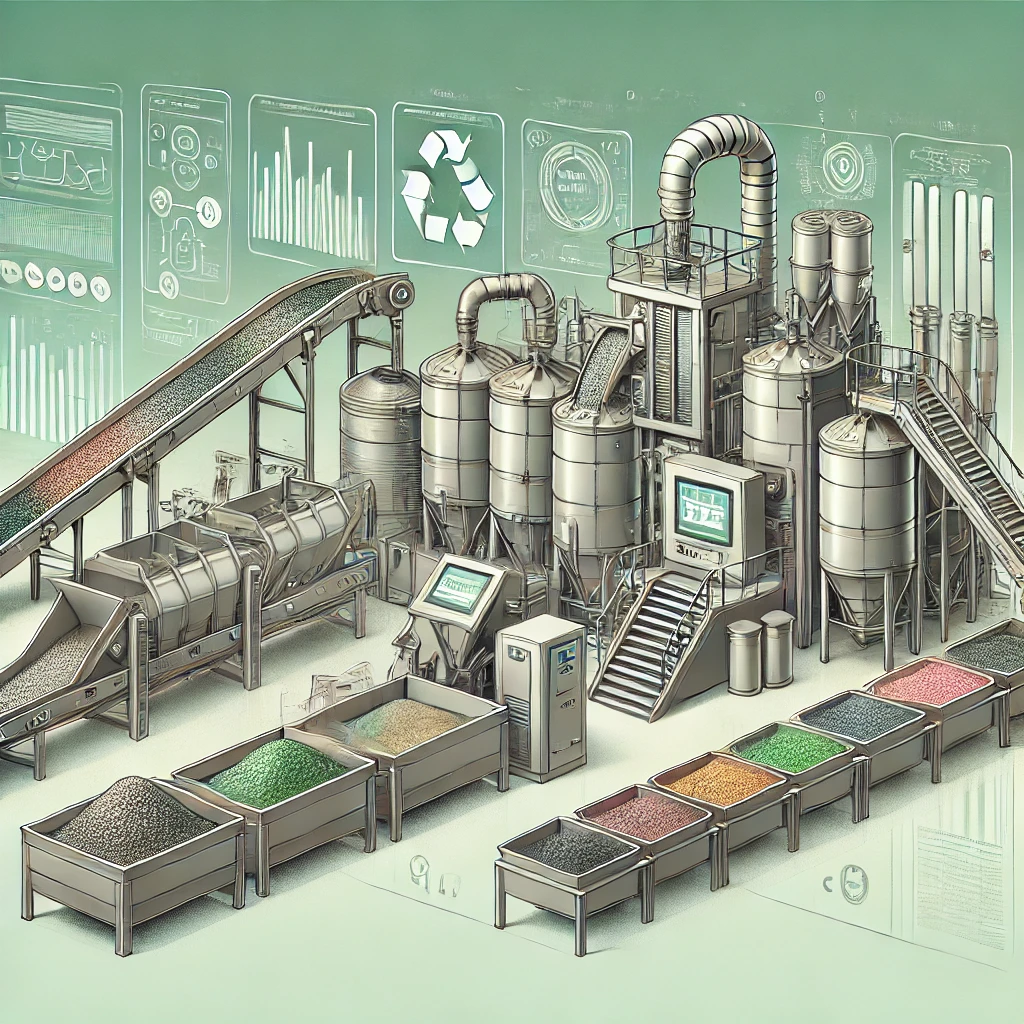Granular recovery technology (GRT) is emerging as a game-changer in the field of sustainable resource management. With industries increasingly focused on minimizing waste and maximizing resource efficiency, GRT provides a viable solution by enabling the recovery of valuable materials from granular waste streams. This blog post delves into the mechanics of granular recovery technology, explores its applications, and discusses the significant benefits it offers to industries aiming for more sustainable practices.
What is Granular Recovery Technology?
Granular recovery technology refers to the processes and systems used to recover valuable materials from granular waste. These granular materials, often resulting from industrial processes, mining, or recycling operations, contain valuable components that can be extracted and reused. GRT employs various techniques such as sorting, separation, and purification to isolate these valuable materials from waste, ensuring that they can be reintroduced into the production cycle.
The Importance of Granular Recovery Technology:
In a world increasingly concerned with sustainability and resource conservation, granular recovery technology plays a crucial role. The technology not only helps in reducing the environmental impact of industrial waste but also contributes to the circular economy by enabling the reuse of materials that would otherwise end up in landfills. Moreover, with the rising costs of raw materials, GRT provides a cost-effective alternative by allowing industries to recover and reuse resources, thus reducing dependency on virgin materials.
Applications of Granular Recovery Technology:
Granular recovery technology finds applications across various industries, each leveraging its unique benefits to enhance sustainability and efficiency. Some key industries include:
-
Mining Industry:
- In the mining sector, GRT is used to recover precious metals and minerals from mining waste. This not only reduces the environmental footprint of mining operations but also allows companies to extract additional value from their existing processes.
-
Construction and Demolition:
- Construction and demolition activities generate significant amounts of granular waste, such as concrete, bricks, and asphalt. Granular recovery technology enables the extraction of usable materials from this waste, which can then be reused in new construction projects.
-
Recycling Industry:
- In recycling, GRT is used to recover materials like plastics, metals, and glass from mixed waste streams. This helps in producing high-quality recycled materials that can be reintroduced into the manufacturing process.
-
Agriculture:
- GRT can be applied in agriculture to recover nutrients from organic waste, which can then be used as fertilizers, reducing the need for synthetic alternatives.
How Granular Recovery Technology Works:
The process of granular recovery typically involves several steps, each designed to maximize the efficiency and effectiveness of material recovery:
-
Collection and Pre-Processing:
- The first step involves collecting the granular waste and preparing it for processing. This may include crushing or grinding the waste to ensure uniform granularity, making it easier to sort and separate the materials.
-
Sorting and Separation:
- Advanced sorting techniques, such as sieving, magnetic separation, and air classification, are used to segregate the granular materials based on size, density, and magnetic properties. This step is crucial for isolating valuable materials from waste.
-
Purification and Refining:
- Once the materials are sorted, purification processes are applied to remove impurities. Techniques like chemical treatment, electrostatic separation, and flotation are commonly used to enhance the purity of the recovered materials.
-
Reintegration;
- The final step involves reintegrating the recovered materials into the production cycle. This may involve re-melting metals, re-processing plastics, or converting organic materials into fertilizers.
Benefits of Granular Recovery Technology:
The adoption of granular recovery technology offers numerous benefits to industries and the environment alike:
-
Environmental Sustainability:
- By enabling the recovery and reuse of materials, GRT significantly reduces the volume of waste sent to landfills, lowering the environmental impact of industrial activities. It also helps in conserving natural resources by reducing the need for virgin materials.
-
Cost Efficiency:
- GRT provides a cost-effective solution for industries by allowing them to recover valuable materials from waste. This not only reduces raw material costs but also lowers waste disposal expenses.
-
Resource Conservation:
- The technology promotes the efficient use of resources by recovering materials that would otherwise be lost. This is particularly important in industries where raw materials are scarce or expensive.
-
Regulatory Compliance:
- With increasing environmental regulations, industries are under pressure to minimize waste and improve sustainability. GRT helps companies comply with these regulations by reducing waste and promoting resource recovery.
-
Support for Circular Economy:
- Granular recovery technology is a key enabler of the circular economy, where materials are continuously reused and recycled, minimizing waste and reducing the overall environmental impact.
Challenges and Future Outlook:
While granular recovery technology offers numerous advantages, it also faces certain challenges:
-
Technical Complexity:
- The technology involves complex processes that require significant expertise and investment in specialized equipment. This can be a barrier for smaller companies looking to adopt GRT.
-
Economic Viability:
- The economic viability of granular recovery depends on the value of the recovered materials and the costs associated with the recovery process. In some cases, the costs may outweigh the benefits, limiting the adoption of the technology.
-
Regulatory Hurdles:
- The implementation of GRT may be hindered by regulatory challenges, particularly in industries with strict waste management and environmental standards.
Despite these challenges, the future of granular recovery technology looks promising. Advances in technology are likely to reduce costs and improve the efficiency of recovery processes, making GRT more accessible to a wider range of industries. Moreover, as sustainability becomes an increasingly important priority for businesses and governments, the demand for granular recovery technology is expected to grow.
FAQs
-
What types of waste can be processed using granular recovery technology?
- Granular recovery technology can process a wide range of waste types, including mining waste, construction debris, recycled materials, and organic waste. The key is that the waste must be in a granular form or can be processed into granules.
-
How does granular recovery technology contribute to the circular economy?
- Granular recovery technology contributes to the circular economy by recovering valuable materials from waste, allowing them to be reused in production cycles. This reduces the need for new raw materials and minimizes waste, supporting a more sustainable economic model.
-
Is granular recovery technology expensive to implement?
- The cost of implementing granular recovery technology can vary depending on the complexity of the processes and the scale of operation. While there are initial investments required for equipment and expertise, the long-term savings from material recovery and waste reduction can make it cost-effective.
-
Can small businesses benefit from granular recovery technology?
- Yes, small businesses can benefit from granular recovery technology, especially if they generate a significant amount of granular waste that contains valuable materials. While the initial investment may be a challenge, partnerships with larger companies or investments in smaller-scale technology can make it feasible.
-
What are the environmental benefits of granular recovery technology?
- The environmental benefits include reduced landfill waste, lower carbon emissions due to decreased need for new raw materials, and conservation of natural resources. Additionally, GRT helps industries comply with environmental regulations by promoting sustainable waste management practices.
-
What future developments can we expect in granular recovery technology?
- Future developments in granular recovery technology may include more efficient and cost-effective processes, advancements in automation and AI-driven sorting techniques, and wider adoption across different industries. As sustainability becomes a global priority, GRT is likely to see increased innovation and application.
Conclusion:
Granular recovery technology is a powerful tool in the quest for sustainable resource management. By enabling the recovery and reuse of valuable materials from granular waste, GRT not only reduces environmental impact but also supports the circular economy and enhances resource efficiency. As industries continue to seek ways to minimize waste and maximize sustainability, granular recovery technology will undoubtedly play a central role in shaping the future of resource management.



